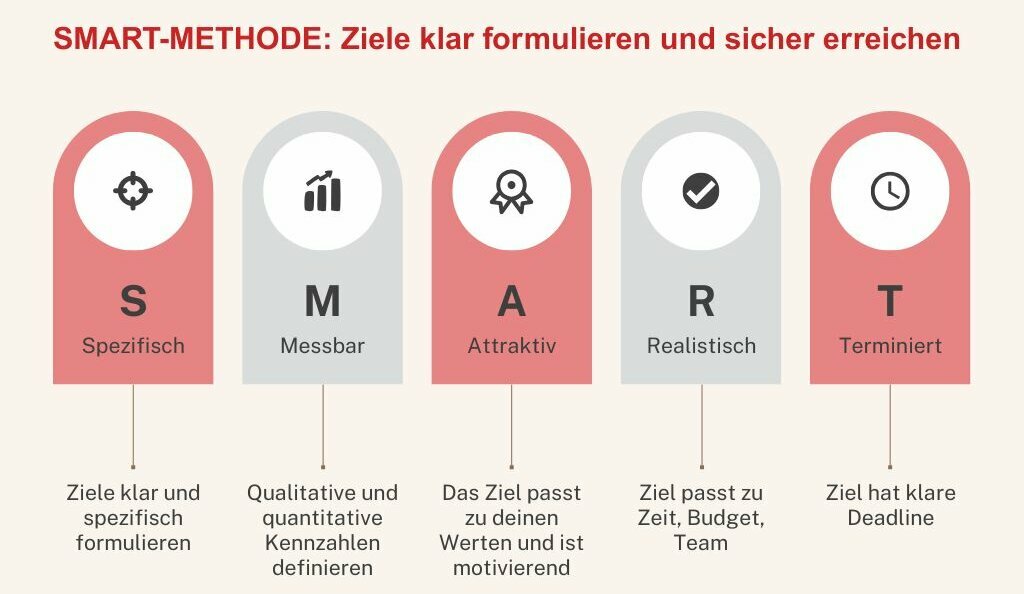What Is the SMART Method?
SMART stands for Specific, Measurable, Attractive, Realistic, and Time-bound. It’s a framework for goal setting used in business and personal contexts alike. The method forces you to clarify what you want to achieve, how to measure it, why it matters, whether it’s feasible, and by when it should be completed. The result: more clarity, stronger motivation, and higher chances of success.
Real-Life Examples
Theory is useful, but only in practice does the true value of the SMART method become clear. Whether in personal life, at work, or in personal development — wherever goals need to be clearly defined, SMART provides structure and direction. Here are three common scenarios that highlight the difference between vague intentions and clearly defined goals:
| Vague Goal | SMART Goal |
Personal | I want to get fitter. | Starting next week, I`ll go jogging three times a week for 45 minutes and aim to run 5 km nonstop after 12 weeks. |
Professional | We want to incrase sales. | We will grow oline shop revenue by 15% by December 31st compared to last year. |
Career Development | I want to advance prfessionally. | I will complete my PMP certification by the end of June and achieve at least 80% on the exam. |
All three examples show that a goal becomes concrete, measurable, and motivating only through the SMART method.
Why the SMART Method Matters
Unclear goals are like fog: you’re moving, but without direction. SMART method clears the fog. Goals become concrete, progress measurable, and deadlines binding. That builds motivation, enables better planning, and provides orientation for both teams and individuals. Instead of ending in frustration (“Didn’t make it again”), you can ask: “Am I on track — and if not, what do I need to adjust?”
Benefits of the SMART Method
- Clear, verifiable goals
- Motivation through visible progress
- Higher success rate
- Works for personal, professional, and team goals
- Shared understanding
- Focus on impact, not activity
- Better measurement and control
- Improved risk and resource management
The roots of the SMART method lie in management theory. As early as the 1950s, Peter F. Drucker developed the concept of Management by Objectives (MBO). His core idea: managers and employees should not just complete tasks, but work toward clearly defined goals. This goal-oriented management approach laid the foundation for many modern methodologies.
However, the term SMART itself was first introduced by George T. Doran in 1981 in the journal Management Review. In his article “There’s a S.M.A.R.T. way to write management’s goals and objectives,” Doran presented the acronym for the first time. He translated Drucker’s more abstract MBO concept into a practical tool that can be easily applied in everyday life. Since then, the SMART method has become established worldwide — from corporations to personal time management.
Applying the SMART Method
The Five Criteria of the SMART Method in Detail
Specific means describing a goal as precisely as possible. “Do more sports” is vague. “I will go jogging three times a week for 45 minutes” is a clear, specific goal. The more precisely a goal is defined, the easier it is to understand — also for others involved.
Measurable makes progress verifiable. Numbers and data matter here. A goal like “I want to gain 10 new customers” is measurable. “I want satisfied customers” is not — unless supported by a metric such as “Customer satisfaction >85% in surveys.” Measurability prevents you from working in the dark.
Attractive means the goal has a tangible benefit for you or your team. Only then does motivation stay high. For example: “I will save €200 per month to afford a summer trip.” It gives you a concrete reason to stay committed.
Realistic checks whether the goal is achievable. Unrealistic expectations quickly lead to frustration. “Become fluent in Spanish within two months” is unrealistic. “Complete a Spanish course and hold simple daily conversations within two months” is realistic. Realism doesn’t mean lowering ambition — it means being ambitious yet attainable.
Time-bound ensures clarity in scheduling. Without a deadline, goals lose urgency. “I will launch my new website by June 30” has a clear timeframe. Deadlines are essential because they create accountability and help you track progress.
Step-by-Step SMART Goal Setting
Die Methode entfaltet ihre Wirkung nur, wenn du deine Ziele schriftlich festhältst und regelmäßig überprüfst. Es ist hilfreich, Zwischenziele zu definieren und die Fortschritte zu dokumentieren. Auch Feedback von Kollegen oder Freunden kann unterstützen, um realistisch zu bleiben und dranzubleiben.
- Write down your rough goal.
- Check it against the five SMART criteria.
- Ask key questions: Who’s responsible? What should be achieved? Why? How? By when?
- Adjust until all criteria are met.
- Document and make it visible — in your calendar, on a whiteboard, or in your project tool.
What if not all criteria are met?
In practice, not everything can always be measured or precisely time-bound. For soft goals like “improving the work climate,” it can be difficult to assign a number. In such cases, substitute indicators such as survey results, feedback sessions, or observations can help. The key is to stay as concrete as possible. Even if a goal isn’t 100% SMART, the act of structuring it that way already adds clarity.
- Difficult to measure: Use proxy metrics, rubrics, or a clear “definition of done.”
- Uncertain timing: Set time windows or rolling forecast milestones.
- Questionable realism: Formulate hypotheses or pilot goals, then decide based on evidence.
- Disputed attractiveness: Clarify the benefit for each stakeholder, adjust the target audience or scope.
- Conflicts: Prioritize along strategic lines, reduce scope, or delay the start.
What happens after defining the goal?
A SMART goal is only the beginning — implementation follows. Break the goal into smaller steps, plan milestones, and review progress regularly. If you realize a goal wasn’t realistic, adjust it. SMART isn’t about rigidity; it’s about providing clear direction.
- Plan implementation: Define work packages, responsibilities, dependencies, and capacities.
- Ensure transparency: Track the goal in a tool, dashboard, or status indicator.
- Lead with metrics: Use leading and lagging indicators; derive weekly goals from monthly objectives.
- Embed learning: Hold retrospectives after each milestone, update assumptions.
- Adapt as needed: Adjust scope, resources, or timing when deviations occur. Establish decision criteria in advance.
Common mistakes and how to avoid them
Before you start, watch out for these pitfalls. They waste time, blur results, and cause frustration. With clear definitions, fixed responsibilities, and a simple review rhythm, you can avoid the most common missteps.
“More,” “better,” “regularly” without numbers → always quantify.
Without a target value, there’s no success criterion. Define the metric, baseline, target value, and timeframe.
Example: instead of “post regularly” → “3 LinkedIn posts per week with at least 2,000 impressions per post by Nov 30.”
Unrealistic deadlines → add buffers and check capacity.
Plan 10–30% time buffer depending on uncertainty. Review dependencies, vacations, and available FTEs.
Example: Go-live +1 week buffer for QA and approvals; identify the critical path.
Goal without responsible person → assign an owner.
Appoint exactly one accountable individual. List supporting roles separately. Define escalation paths.
Example: “Owner: Marketing Lead; Contributors: Content, Performance; Escalation: CMO.”
Metrics without a source → define the data source.
Without a source, there’s no comparability. Decide on the tool, measurement method, frequency, and “definition of done.”
Example: “Leads according to HubSpot, monthly export, UTM standard active.”
Goal without reviews → set fixed review dates.
Regular check-ins ensure course corrections. Operative reviews weekly, result reviews monthly. Define decision rules in advance.
Example: “If CTR < 1.2% after 7 days → replace creatives; monthly review on the first working day.”
SMART in Practice: Strengths and Limitations
SMART provides clear formulations, measurable progress tracking, and defined responsibilities. Goals become comparable, planning more reliable, and motivation higher because success is visible. In teams, SMART fosters shared understanding and reduces misinterpretation.
Limitations arise when only measurable factors count. A short-term bias can replace long-term focus. Numbers may create false precision, creativity can suffer from over-structuring, and too many SMART goals lead to bureaucracy. Soft topics like culture or innovation are often only indirectly measurable.
The solution is to use SMART as a tool — not as dogma. Combine it with a broader strategic framework (e.g., OKRs or a North Star Metric), include qualitative indicators with a clear “definition of done,” create space for experimentation, limit the number of active goals, and plan regular review and adjustment loops (SMARTER: Evaluate and Readjust). The result: focus and measurability remain — without losing sight of the bigger picture.
Whether in projects, teams, or personal development, the SMART method is a simple yet effective approach to make goals measurable and achievable. Those who work with SMART increase the likelihood that plans won’t just stay on paper but will actually be put into action.
|
OKR (Objectives & Key Results): A directional objective plus 3 to 5 measurable key results. Quarterly rhythm, strong team alignment, and transparency. Ideal for focusing on outcomes and priorities across departments. FAST Goals (Frequently discussed, Ambitious, Specific, Transparent): Ambitious, regularly reviewed, clear, and visible to everyone. Encourages speed and learning loops instead of "set and forget" lanning. HARD Goals (Heartfelt, Animated, Required, Difficult): Emotion-driven and challenging. Increases commitment when motivation is crucial and change needs to be tangible. CLEAR Goals (Collaborative, Limited, Emotional, Appreciable, Refinable): Collaborative, broken down into smaller steps, and adaptable. Useful in dynamic environmensts with uncertainities. WOOP (Wish, Outcome, Obstacle, Plan): Mental contrasting with "if-then" planning. Ideal as a complement - anticipates obstacles and defines concrete reactions so that goals actually happen in daily life. |
|

